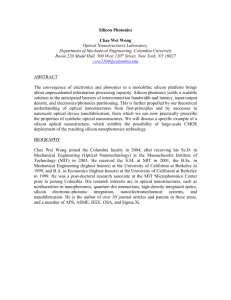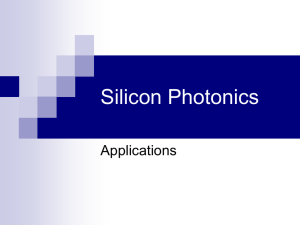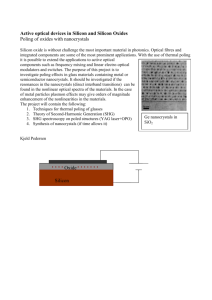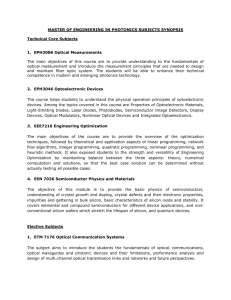Project Title - IITB-Monash Research Academy
advertisement
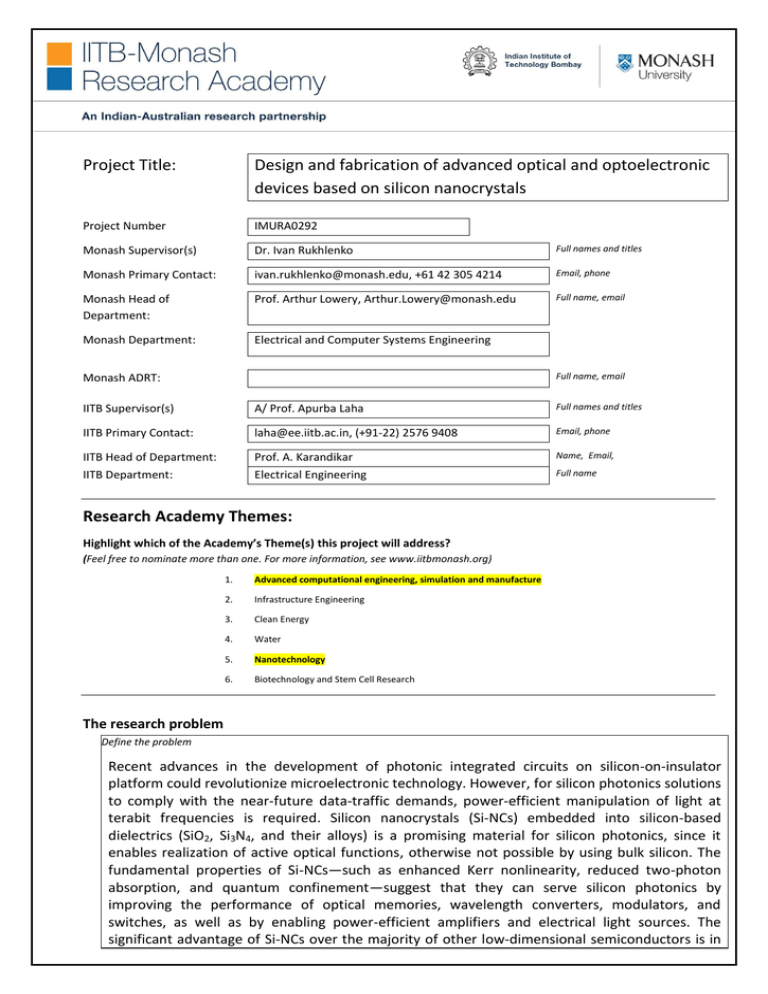
Project Title: Design and fabrication of advanced optical and optoelectronic devices based on silicon nanocrystals Project Number IMURA0292 Monash Supervisor(s) Dr. Ivan Rukhlenko Full names and titles Monash Primary Contact: ivan.rukhlenko@monash.edu, +61 42 305 4214 Email, phone Monash Head of Department: Prof. Arthur Lowery, Arthur.Lowery@monash.edu Full name, email Monash Department: Electrical and Computer Systems Engineering Full name, email Monash ADRT: IITB Supervisor(s) A/ Prof. Apurba Laha Full names and titles IITB Primary Contact: laha@ee.iitb.ac.in, (+91-22) 2576 9408 Email, phone IITB Head of Department: IITB Department: Prof. A. Karandikar Electrical Engineering Name, Email, Full name Research Academy Themes: Highlight which of the Academy’s Theme(s) this project will address? (Feel free to nominate more than one. For more information, see www.iitbmonash.org) 1. Advanced computational engineering, simulation and manufacture 2. Infrastructure Engineering 3. Clean Energy 4. Water 5. Nanotechnology 6. Biotechnology and Stem Cell Research The research problem Define the problem Recent advances in the development of photonic integrated circuits on silicon-on-insulator platform could revolutionize microelectronic technology. However, for silicon photonics solutions to comply with the near-future data-traffic demands, power-efficient manipulation of light at terabit frequencies is required. Silicon nanocrystals (Si-NCs) embedded into silicon-based dielectrics (SiO2, Si3N4, and their alloys) is a promising material for silicon photonics, since it enables realization of active optical functions, otherwise not possible by using bulk silicon. The fundamental properties of Si-NCs—such as enhanced Kerr nonlinearity, reduced two-photon absorption, and quantum confinement—suggest that they can serve silicon photonics by improving the performance of optical memories, wavelength converters, modulators, and switches, as well as by enabling power-efficient amplifiers and electrical light sources. The significant advantage of Si-NCs over the majority of other low-dimensional semiconductors is in their natural compatibility with the complementary metal-oxide-semiconductor (CMOS) technology, which will allow integration of all silicon-based functionalities within a single photonics platform, and mass manufacturing of various photonic devices at low costs. However, before these devices become a reality and result in the first commercial products, silicon Nano photonics must evolve from an emerging field of research to an available technology by resolving a number of outstanding challenges. These include: (i) demonstration of the injection laser; (ii) minimization of, or compensation for, the absorption losses; (iii) precise control of Si-NC size during the fabrication process; and (iv) employment of the full power of third-order nonlinear effects in Si-NCs. This project will comprehensively address the last of these challenges. Project aims Define the aims of the project This PhD project aims to design and prototype active photonic devices with superior performance based on the strong and ultrafast Kerr nonlinearity of Si-NCs. With the engineering of these devices, the PhD student will explore and describe the fundamental physics governing their operational behaviour, as well as gain deep insight into the optical properties of Si-NCwaveguides. He/ She will also perform fundamental research aiming to suggest, optimize, and demonstrate theoretically novel approaches for controlling light with optical and electrical signals. This project pursues several main goals, all of which are expected to uncover new physical phenomena and deliver high-impact research outcomes: Development of the unified theory of nonlinear optical phenomena modified by the spatial confinement in Si-NC-rich silica waveguides. The theory will incorporate all major nonlinear effects stemming from the third-order susceptibility of silicon, take into account modification of electronic spectra of Si-NCs due to the quantum confinement effect, and allow for saturation of optical nonlinearities due to a band filling mechanism. Identification of novel concepts for ultrafast and power-efficient optical switching, modulation, and wavelength conversion in Si-NC-waveguides by considering different operation schemes, waveguide geometries, and arrangements of Si-NCs, or by following other nontrivial paths for enhancing the active performance of low-dimensional silicon. Theoretical demonstration of the active optical functions by carrying out detailed numerical simulations of light propagation through Si-NC-waveguides. Design and optimization of the relevant integrated photonic devices. Understanding the growth of Si-NCs embedded in dielectric matrix and essentially optimizing the growth condition for a specific growth technique. Characterization of Si-NCs and comparison of the results with simulated parameters. Implementation of the proposed innovative concepts by prototyping the developed optimized devices and their experimental characterization. Expected outcomes Highlight the expected outcomes of the project The proposed project is of strategic interest to both India and Australia because of its prospective industrial, economic, and social impacts. It will introduce and demonstrate novel concepts for the realization of ultrafast and power-efficient switching, modulation, and wavelength conversion of light in Si-NC-waveguides, which will result in immediate practical applications in the telecommunications industry. Furthermore, through the creation of extensive theoretical knowledge and by suggesting practical applications at the leading edge of nonlinear photonics— photonics of silicon nanocrystals—the project will make significant contribution to the designated priority area “Frontier Technologies for Building and Transforming Australian Industries.” This will help to build and maintain Australia’s global competitiveness in the rapidly developing field of silicon nanophotonics, which is currently a hot research topic being actively pursued at the leading research centers around the world. On a global scale, this project will give India and Australia a world-leading technology with potential future commercialization, and strengthen India’s and Australia’s stake in the optoelectronics industry. It is significant, therefore, that the intellectual property, which will emerge as a result of the project, may be protected through well-established mechanisms at Monash University. The joint work of the Advanced Computing and Simulation Laboratory (headed by Prof. Malin Premaratne) and the research group from the Electrical Engineering Department (headed by Prof. Apurba Laha) initiated by the project will result in significant technology and knowledge transfer between Monash University and IIT Bombay and will lead to the gaining of valuable experience by the two research groups. The realization of the project by a student from the Electrical Engineering Department will give him/her unique skills and knowledge in the rapidly developing area of silicon nanophotonics, and eventually increase the competitive strength of India/Australia in the high-tech market. These, and potentially other, outcomes of this PhD research project are vitally beneficial to both India and Australia—either by supporting local industry, creating strong international relations; through development of human capital, enhancing collaboration and research efficiency; or by publicizing India’s and Australia’s research excellence. How will the project address the Goals of the above Themes? Describe how the project will address the goals of one or more of the 6 Themes listed above. The PhD project is developed to most efficiently perform the research in novel directions and to thoroughly address the goals of the research themes “Advanced computational engineering, simulation and manufacture” and “Nanotechnology”. The PhD student will first use the contemporary methods of optics, quantum mechanics, and solid-state physics to build a thorough theoretical model of nonlinear optical phenomena in Si-NCs. He/she will then use approximate methods and simplifying assumptions, such as the coupled-mode theory and slowly varying amplitude approximation, to perform analytical and semi-analytical studies with the emphasis on identifying novel effects and design strategies essential for the project. The solutions to be obtained will provide not only a rapid way of checking simulation results, but also considerable physical insight that is often lost in the voluminous data generated by numerical simulations. Then, he/she will perform detailed numerical simulations and suggest the optimal schemes for ultrafast manipulation of light with Si-NCs and the best design for the integrated photonic switches, modulators, and wavelength converters. During the process of fabricating prototype optical devices, such as waveguides, the student will learn the most modern techniques of growing Si-NCs, such as molecular beam epitaxy (MBE), sputtering and pulsed laser ablation, which are already available in IITB. As the optical properties of Si-NCs strongly depend on their sizes and shapes, he/she will perform systematics investigations to optimize process/experimental parameters to grow Si-NCs with pre-defined physical properties. This is one of the most challenging problems in this subject. He/she will perform series of experiments related to growth, in order to understand the mechanism of Si-NC growth embedded into oxide dielectric and hence come out with precise experimental parameters. Furthermore, the dielectric matrix surrounding of Si-NCs also play critical roll to optical properties of the nanocrystals. Number of dielectrics, such as SiO2, Si3N4, their alloys, and few crystalline oxides will be studied to find out the best possible dielectric matrix for such optical devices. Furthermore, Si-NCs will be doped with few rare earth ions such as Er+3 and Tb+3, in order to study their impact on light emission from Si-NCs. During the entire span of the project, the student will be learning how to work with the state-of-the-art fabrication facilities at IIT Bombay, in order to prototype and experimentally characterize the proposed devises at the final stage of the research project. Time line (Year) Subject 1 2 3 Theory and simulations Selection of materials, including high-k dielectrics Growth and characterization of Si-NCs Compare experimental data with simulation results Prototyping optical waveguides and their characterization Capabilities and Degrees Required List the ideal set of capabilities that a student should have for this project. Feel free to be as specific or as general as you like. These capabilities will be input into the online application form and students who opt for this project will be required to show that they can demonstrate these capabilities. The student must have a strong theoretical and/or experimental background in engineering and optics (including extensive courses of electrodynamics, solid-state physics, and nanotechnology), a GPA score above 3.9 (out of 4), Academic-IELTS scores of 7 (out of 9) or above for each test component (listening, reading, writing, and speaking). It is also desirable to have at least one journal and/or several major conference publications.
